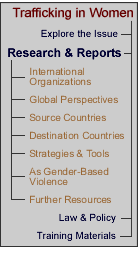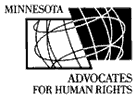|
|
|
Strategies and Tools The following reports provide general resources useful for nongovernmental organizations (NGOs) and also information that may inform NGO advocacy strategies. Human rights NGOS and intergovernmental organizations have recognized specific areas that must be strengthened in order to ensure effective protection of victims and prosecution of traffickers. For example, this section includes draft standards for the treatment of trafficking victims and strategies to ensure that victims who serve as witnesses are protected. Likewise, this section contains research on legislative reform, which point to particular weaknesses in national legal systems. Law
Enforcement Co-operation with Non-Governmental Organizations, with
reference to the Protection of Victims and Victims as Witnesses,
Paul Holmes, International Law Enforcement Coordination Consultant,
from the European Conference on Preventing and Combating Trafficking
in Human Beings, Global challenge for the 21st century, Brussels,
18-20 September 2002. [PDF, 29 pages]. Trafficking
in Human Beings in [European Union] Candidate Countries, Dr.
Lenke Fehér, Senior Scientific Researcher, National Institute Of
Criminology, Budapest, from the European Conference on Preventing
and Combating Trafficking in Human Beings, Global challenge for
the 21st century, Brussels, 18-20 September 2002. [PDF, 38
pages]. A
Resource Book for working against Trafficking in Women and Girls:
Baltic Sea Region, Kvinnoforum, Stockholm, Crossing
Borders Against Trafficking in Women and Girls: A Resource
Book for Working Against Trafficking in the Baltic
Sea Region, Kvinnoforum, Stockholm, Trafficking
in Women for the Purpose of Sexual Exploitation: Mapping the
Situation and Existing Organizations Working in Trafficking
In Women: Innovative Strategies And Tools For Action,
Final Report of the Conference Organized by the International Helsinki
Federation for Human Rights in Cooperation with La Strada-Ukraine,
held in Vienna, November 2001. [PDF,
52 pages]. Victim Protection and Victim’s Rights Trafficking
of human beings: methods and measures for defending and supporting
the victims, report presented by Giuseppe Roma, General Director,
Centro Studi Investimenti Sociali (CENSIS), Rome, Italy, from the
European Conference on Preventing and Combating Trafficking in Human
Beings, Global challenge for the 21st century, Brussels, 18-20 September
2002. [PDF, 25 pages]. Law
Enforcement Co-operation with Non-Governmental Organizations, with
reference to the Protection of Victims and Victims as Witnesses,
Paul Holmes, International Law Enforcement Coordination Consultant,
from the European Conference on Preventing and Combating Trafficking
in Human Beings, Global challenge for the 21st century, Brussels,
18-20 September 2002. [PDF, 29 pages]. Human
Traffic, Human Rights: Redefining Victim Protection, Anti-Slavery
International, 2002. [PDF, 231 pages]. A Human Rights Approach to the Rehabilitation and Reintegration into Society of Trafficked Victims, remarks by Widney Brown, Human Rights Watch, from "21st Century Slavery - The Human Rights Dimension to Trafficking in Human Beings," Conference in Rome, Italy, 2002. The Need for Effective Witness Protection in the Prosecution of Traffickers: a Human Rights Framework for Witness Protection, presentation by Elaine Peterson, Trafficking Program Officer, Anti-Slavery International, February 2001. [PDF, 15 pages]. Women as Victims and Survivors in the Context of Transnational Crime, Edna Erez, Justice Studies Department, Kent State University, presented at the 10th United Nations Congress on Crime Prevention and The Treatment of Offenders in Vienna, Austria, 10-17 April 2000. Human Rights Standards for the Treatment of Trafficked Persons, Global Alliance Against Traffic in Women, the Foundation Against Trafficking in Women and the International Human Rights Law Group, January 1999. [PDF, 17 pages] Put
in Harm's Way: The Neglected Health Consequences of Sex Trafficking
in the Trafficking
of Women and Children for Sexual Exploitation in The
Reference Guide for Anti-Trafficking Legislative Review, Office for Democratic Institutions and Human Rights (ODIHR), Organization for Security and Cooperation in Europe (OSCE), September 2001. [PDF, 114 pages]. Also available in Russian: Руководящие
Принципы по
Пересмотру
Законодательства
против Торговли
Людьми, [PDF, 151 pages]
and in Serbian: Priručnik
za Reviziju Zakonske Regulative protiv Trgovine Ljudima, [PDF,
138 pages]. The Trafficking and Smuggling of Refugees: the End Game in European Asylum Policy?, UNHCR Working Paper, John Morrison and Beth Crosland, UNHCR Policy Research Unit, April 2001 (No. 29). [PDF, 93 pages]. The
Swedish Approach to Prostitution, Sari Kouvo, Department of
Law, University of Göteborg, |
| Home | Contact | Feedback | Disclaimer |

